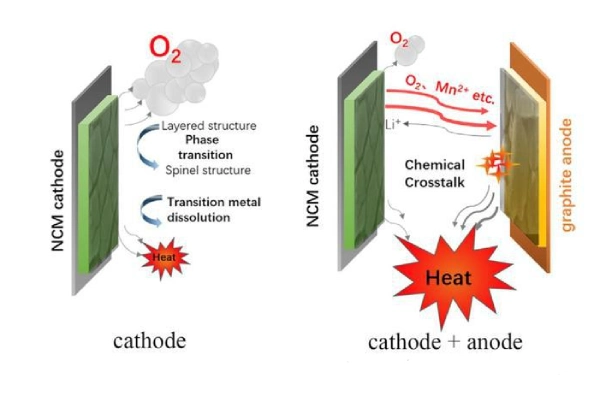With the development of technology, electric vehicles have gradually entered people’s view. As the core part of electric vehicles, the safety and stability of batteries are crucial. In recent years, LiFePO4 thermal runaway has gradually received attention. In this article, we will discuss the causes, effects, and solutions of LiFePO4 battery thermal runaway.
Part 1. Causes of LiFePO4 thermal runaway
LiFePO4 battery thermal runaway is a complex process, involving a variety of factors. The following are the main reasons:
1. LiFePO4 battery internal short circuit
LiFePO4 battery internal short circuit can be caused by defects in the battery manufacturing process, damage during use, or accumulation of electrolytes inside the battery. The large amount of heat generated by the short circuit cannot be emitted in time, triggering thermal runaway.
2. Over-charging or over-discharging.
When lithium iron phosphate LiFePO4 batteries are overcharged or overdischarged, it will cause the internal temperature of the battery to rise, which will lead to thermal runaway.
3. External environmental influences
External environmental factors such as high temperature, extrusion, pinprick may also trigger thermal runaway.

Part 2. LiFePO4 thermal runaway
LiFePO4 thermal runaway will not only affect the performance of the battery but also may cause safety problems.
1. Battery performance degradation
Thermal runaway will cause the internal temperature of the LiFePO4 battery to increase, which will reduce the capacity of the battery, charge and discharge performance, and shorten the service life of the battery. 2.
2. Safety risk
The high temperature generated by the thermal runaway of LiFePO4 may cause fire or explosion, posing a threat to the safety of people and property.
3. Electric vehicle performance is affected
Lithium iron phosphate LiFePO4 batteries are the power source of electric vehicles. thermal runaway of LiFePO4 may affect the normal operation of the vehicle, or even lead to the vehicle can not start.
Part 3. Solution for LiFePO4 thermal runaway
To reduce the risk of LiFePO4 thermal runaway, countermeasures can be taken in the following aspects.
1. Battery pack balancing management
Ensure that each cell in the battery pack is in a similar working condition through balanced management techniques to avoid overcharging or over discharging of individual cells.
2. Battery cooling system optimization
Adopt advanced cooling technology, such as liquid cooling, heat pipe cooling, etc., to improve the heat dissipation performance of the battery and reduce the risk of LiFePO4 thermal runaway.
3. Battery thermal management
Establish an effective thermal management system. Real-time monitoring and temperature control of the battery pack to avoid thermal runaway caused by high temperature.
4. Enhance battery safety testing
Through X-ray testing, ultrasonic testing and other means of battery safety performance testing. Timely detection of potential safety hazards.
5. Enhance the quality of battery manufacturing
Strengthen the control of the battery manufacturing process. Improve the consistency and reliability of the battery and reduce the risk of thermal runaway caused by manufacturing defects.
6. Correct use and maintenance of batteries
Understand the characteristics of lithium iron phosphate LiFePO4 batteries and the precautions for their use to avoid overcharging or over-discharging due to improper use.
7. Establishing contingency plans
For the possible thermal runaway of LiFePO4 batteries, establish a corresponding emergency plan to ensure that the incident can be dealt with in a timely and effective manner to maximize losses.
8. Battery recycling
Establish a perfect battery recycling system, professional treatment and recycling of decommissioned batteries to reduce safety problems caused by improper disposal of used batteries.
9. Research and development of new safety batteries
Continuously carry out research and development of new safe batteries, and seek safer and more reliable battery materials and processes. Fundamentally reduce the risk of thermal runaway of batteries.
10. Strengthen policy regulation
The government should strengthen the supervision of the lithium iron phosphate battery industry, formulate strict industry standards and norms, and promote the healthy development of the industry. At the same time, production enterprises that violate safety regulations should be severely punished by the law.
Summary
LiFePO4 thermal runaway is a complex problem that needs to be studied and coped with from many aspects. By taking effective countermeasures, the risk of LiFePO4 battery thermal runaway can be reduced to ensure the safe and stable operation of electric vehicles. At the same time, relevant research and investment should continue to be strengthened to promote the continuous progress and innovation of lithium iron phosphate LiFePO4 battery technology to provide strong support for the development of the electric vehicle industry.
FAQs
-
Can LiFePO4 batteries go into thermal runaway?
LiFePO4 batteries have a lower risk of thermal runaway compared to other lithium-ion chemistries due to their stable chemistry and higher thermal stability. -
What is the thermal runaway temperature of the LFP battery?
The thermal runaway temperature of an LFP battery is typically above 250°C, which is higher than other lithium-ion chemistries. -
What are the thermal runaway gases in LFP?
LFP batteries produce minimal or no hazardous gases during thermal runaway, making them safer compared to other lithium-ion chemistries. -
Can lithium batteries have thermal runaway?
Yes, lithium batteries, including LiFePO4, can experience thermal runaway if they are subjected to extreme conditions, such as overheating, overcharging, or physical damage.
Related Tags:
More Articles

Overview of Deep Cycle Lithium Battery
In this article, we explore the life, voltage, capacity, and charging considerations of deep cycle lithium batteries.
How Long do Lithium Batteries Last?
How long do lithium batteries last? we will explore the factors that influence the lifespan of lithium batteries and provide insights into their longevity.
How to Choose the Best LiFePO4 Battery?
Choose LiFePO4 batteries for superior performance, safety, and versatility in EVs, UPS, and backup power. This guide helps you make informed decisions.
Get 12v Lithium Car Battery As a Power Source for the Ride
Make the right choice for your vehicle's battery needs by installing a 12 volt lithium car battery. You will enjoy maintenance-free longevity with this change.
Everything About A Small Lithium Ion Battery
Discover the features, uses & future potential of a small lithium ion battery. A compact and tiny powerhouse ideal for smartphones, wearables, drones & more.





